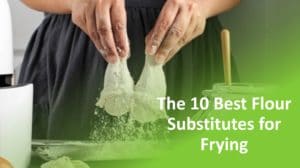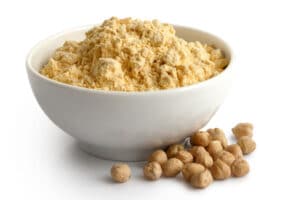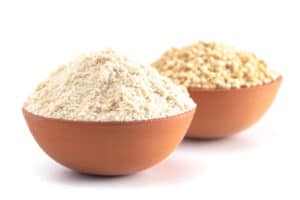Buckwheat flour is produced from the seeds of the buckwheat plant and is frequently used in gluten-free recipes for both sweet and savory goods. It gives quick bread, yeast bread, and other delicacies a delicious nutty flavor, moisture, and tenderness.
If you don’t have any buckwheat flour on hand, it can be replaced with many gluten-free options.
The best buckwheat flour substitutes are: almond flour, oat flour, sorghum flour, brown rice flour, coconut flour, teff flour, and amaranth flour. Let’s learn more about them.
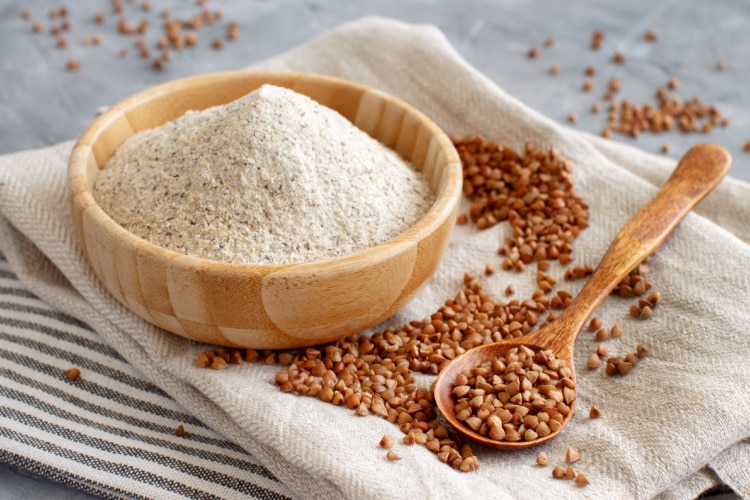
Buckwheat Flour Substitutes: Nutritional Value & Cooking Ratio
| One cup of: | Calories | Fat | Carb | Protein | Fiber | Ratio |
| Almond flour | 648 | 56g | 24g | 24g | 14g | 1:1 |
| Oat flour | 420 | 9.5g | 68g | 15g | 6.8g | 2:1 |
| Sorghum flour | 434 | 4g | 93g | 10g | 8g | 1:1 |
| Brown rice flour | 574 | 4.4g | 121g | 11g | 7.3g | 2:1 |
| Coconut flour | 466 | 16.79g | 65.8g | 17.4g | 6.9g | 1:1 |
| Teff flour | 587 | 3.8g | 117g | 21g | 13g | 1:1 |
| Amaranth flour | 485 | 11g | 79g | 18g | 7.8g | 1:1 |
What Does Buckwheat Flour Taste Like?
Buckwheat has a quite earthy and somewhat nutty taste with very slight sour or bitter undertones.
Goods baked with buckwheat flour are more delicate and moist. The flour is included in a broad range of dishes, such as soba noodles, pancakes, banana bread, traditional Russian blini, traditional French buckwheat crepes, and many more.
Buckwheat Flour Nutritional Value
One cup of buckwheat flour contains:
- 402 calories
- 3.7g fat
- 85g carbs
- 12g fiber
- 15g protein
Substitutes for Buckwheat Flour
Almond Flour
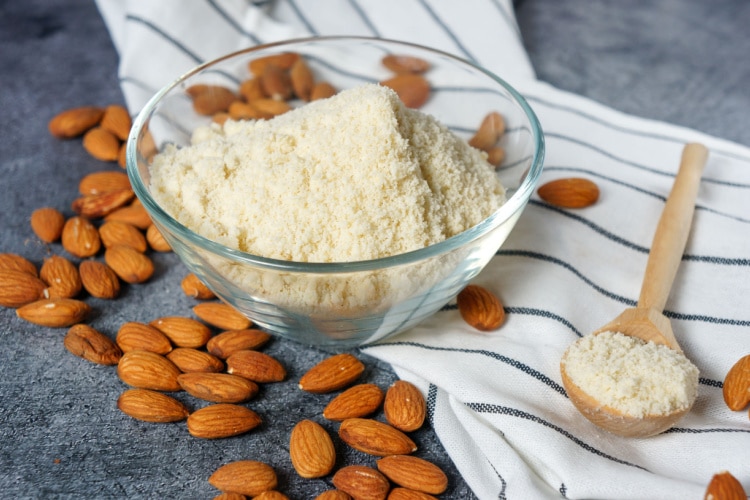
Made from finely ground almonds, almond flour is perfect for gluten-free baked goods. It has a slightly nutty flavor, similar to buckwheat.
Almond flour is loaded with nutrients, from protein and manganese to potassium and vitamin E. Additionally, it has a low glycemic index of under 1, while buckwheat flour has a glycemic index (GI) of 30 to 35. A low GI diet (below 50) can help you manage weight due to reduced insulin and blood sugar. This adds to almond flour’s already great health-related characteristics.
Almond flour produces moist and crumbly baked goods, but you can always make up for that by combining it with eggs, xanthan gum, or other binders. In order to preserve their structure, it is also preferable to let them cool fully before serving.
Oat Flour
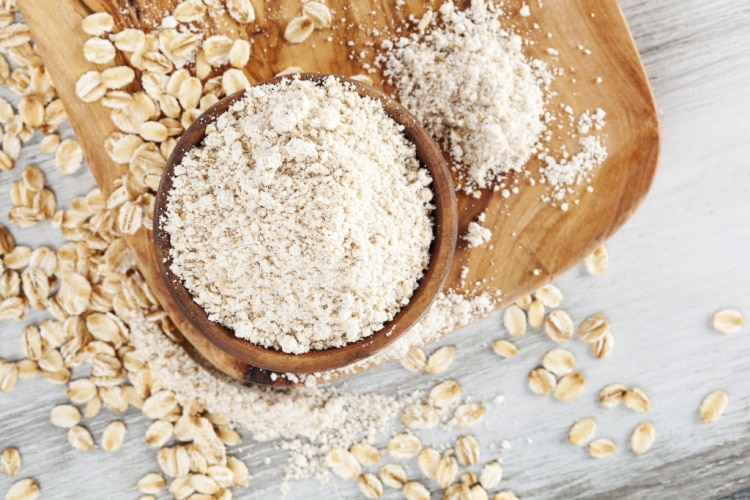
Oat flour, as the name suggests, is made from ground oats. It has a beautiful, mild, nutty taste. It’s also very healthy since it has a high protein, fiber, iron, and calcium content and a low GI of 44.
Many people get confused about oat flour, thinking that oats contain gluten, but they don’t. However, they are subject to cross-contamination, so always double-check the contents of the package.
It goes heavenly well in conjunction with other flours because if used alone, it may result in crumbly goods. Once combined with other flours, like almond, it produces silky smooth doughs.
While oat flour is widely available, you can also make it at home rather easily. Simply blend whole oats in a blender until they become fine flour.
Sorghum Flour
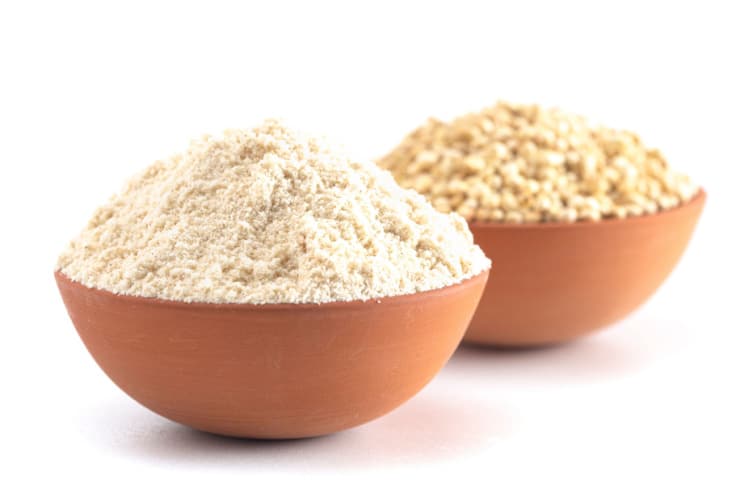
Sorghum flour, another flour that has attained the status of a superfood, is an excellent alternative to buckwheat flour. The sorghum plant first began to grow in Africa some 5,000 years ago, but nowadays, it’s widely utilized in all sorts of dishes.
Sorghum flour is a nutrient powerhouse — it’s high in fiber, protein, B vitamins, and antioxidants. Moreover, it’s gluten-free, as it derives from a cereal grain.
Since it’s a member of the grass family, it contains no wheat. However, it does contain a higher GI score of 70, which makes it a medium glycemic index flour.
When substituted for buckwheat, sorghum will add structure and firmness to baked delights. Additionally, it makes a delicious, crispy coating when applied to fried foods.
Cream-colored sorghum is the most widely used variety, but you can also find it in white, yellow, deep red, brown, and purple hues. It’s advisable to use lighter sorghum flours if you want a replacement that won’t change the color of your dish.
Brown Rice Flour
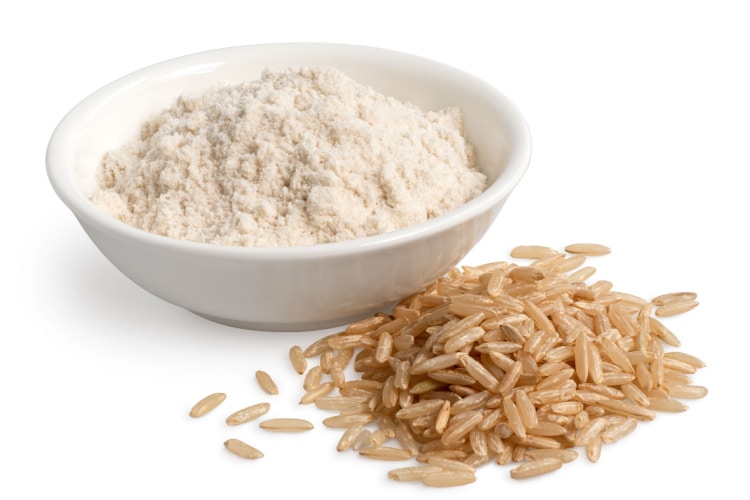
Brown rice flour is whole-grain rice that has been pulverized and processed in a way that the outer bran layer is maintained.
It contains high magnesium levels, a GI score of 50, and copious amounts of dietary fiber.
You can replace buckwheat flour with brown rice since both grains have comparable rich, nutty aromas. However, baked goods made with brown rice flour may be thicker, so combining it with another sort of flour, such as almond, is preferable.
You can substitute buckwheat flour for brown rice flour in yeast bread, quick bread, banana cakes, pancakes, and even pie crusts.
Furthermore, it is effective as a coating for fried dishes and as a thickening agent in gravies, sauces, and soups.
Coconut Flour
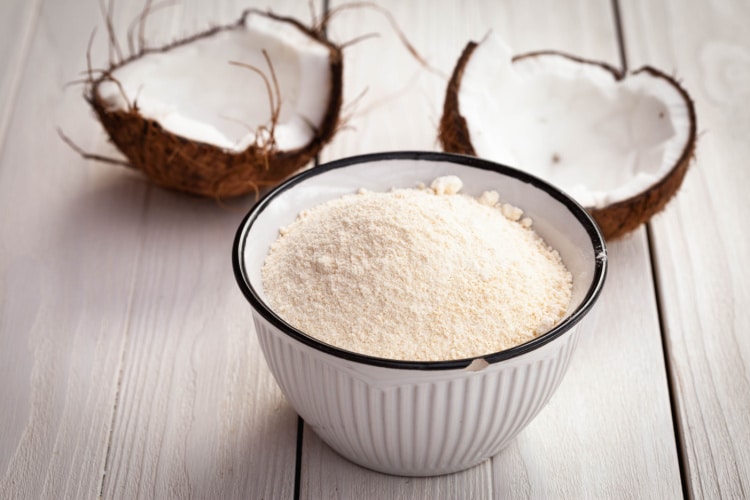
Coconut flour is made by grinding dried coconuts, and it has a taste that is naturally sweet and delightful.
Coconut flour has a GI score of 45. It’s also rich in protein and iron and low in digestible carbs. Because it contains a lot of fiber, you will feel full for a longer period of time.
When it comes to absorption, coconut flour is similar to a sponge. So, if it isn’t balanced with fluids, it might lead to an extremely dry product.
You might need to use more eggs in your recipe to compensate and retain a good structure. If you wouldn’t want to include extra fat and calories in your recipe, you can only use egg whites.
For those that don’t eat eggs, go with either chia seeds and water or arrowroot and tapioca.
Teff Flour
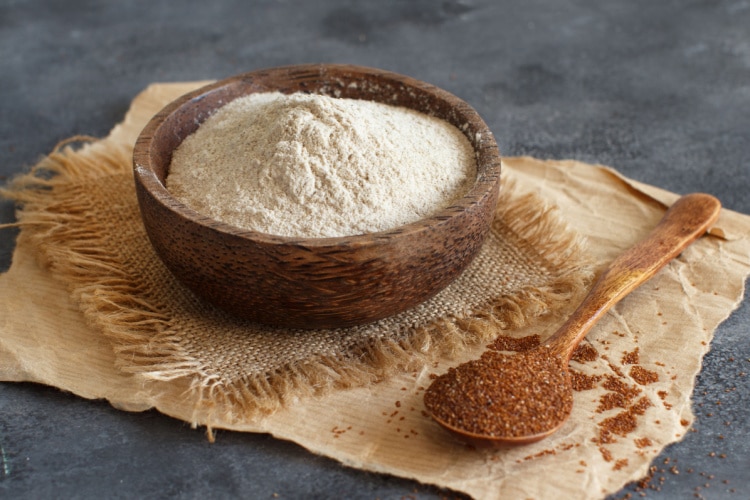
Teff is a cereal grain that mostly grows in eastern Africa, and as the name suggests, it’s the source of our next alternative — teff flour.
Teff flour is highly nutrient-dense. It is a rich source of protein and dietary fiber, calcium, iron, vitamin C, and amino acids. It also has a somewhat moderate GI score of 57.
Teff flour has a slightly sweet and subtly nutty flavor. It comes in white, red, and brown colors. The deeper shades often have a stronger, earthier taste, whereas the lighter ones have a softer flavor.
Because it has about the same amount of protein and fiber as buckwheat, it’s probably the ideal buckwheat substitute. It also works flawlessly with denser doughs like waffles, cupcakes, quick bread, and pastries.
Amaranth

Amaranth flour, which is slightly lower in fiber and protein than buckwheat, is another fantastic substitute for buckwheat flour. The gently sweet, nutty taste and fine texture make it an excellent flour for gluten-free baking.
Amaranth flour is made from the plant’s seed and is inherently gluten-free. It can be used on its own or in combination with other flours.
It has a GI score of 107, which is pretty high, making it an ill-suited alternative for diabetics or those who are trying to lose weight.
Nevertheless, amaranth flour is excellent in baked goods. However, it does tend to absorb a lot of liquid, causing your dish to become excessively dense.
If you aim for thicker textured goods, then amaranth is perfectly fine to use on its own. But if you like your goods more moist and airy, then use additional leavening agents, like baking soda, and combine it with other flours like almond.
Popular Recipes That Call for Buckwheat Flour
Buckwheat flour is used to make fiber- and protein-rich goodies that are both delicious and hearty.
It’s definitely one of our favorite ingredients to use — it’s gluten-free and delicious in anything from banana bread to soba noodles.
So if you are looking for some gluten-free inspiration, we encourage you to try these recipes. We guarantee you won’t regret it.
Buckwheat Pancakes
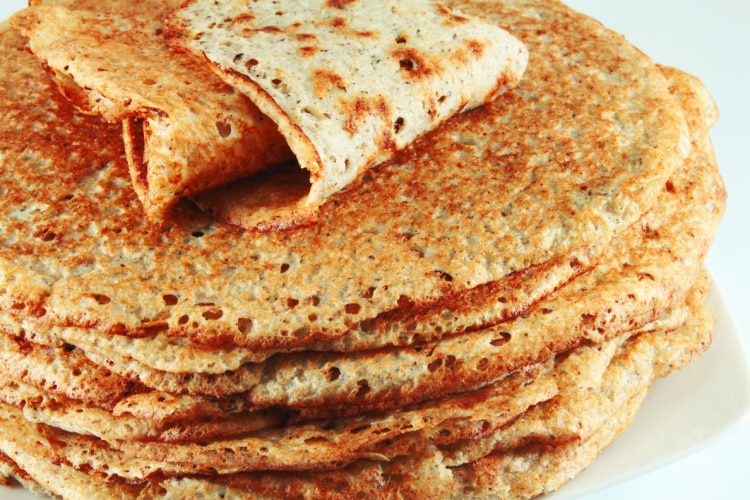
Looking for a nutty-flavored and gluten-free pancake recipe? Then you must try these delicious buckwheat pancakes!
They are extremely fluffy and light, making them the ideal gluten-free choice for a tasty breakfast treat. They are also quite simple to make. Combine the ingredients and griddle-cook them. Enjoy the pancakes with honey, simple syrup, and fresh berries.
Buckwheat Banana Bread
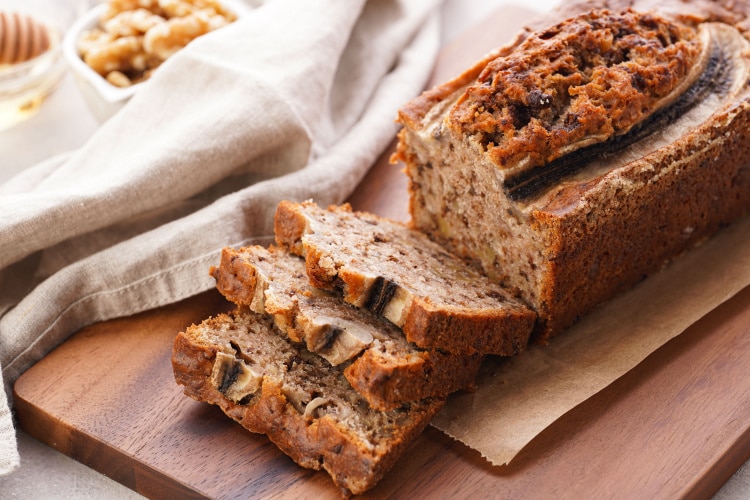
The best way to start your day is with some buckwheat banana bread. Plus, it’s a fantastic way to use overripe bananas.
The texture of banana bread is lovely, and the flavor is heavenly nutty and delicious. What’s more, it isn’t loaded with sugar, so it makes a nutritious breakfast or snack. It tastes best when paired with a cup of tea or coffee.
Buckwheat Cinnamon Rolls
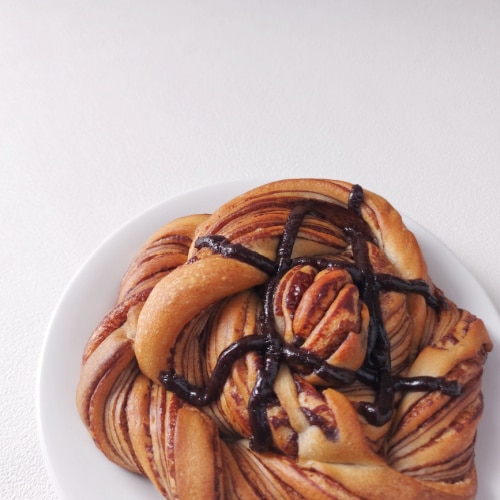
Who would have thought gluten-free cinnamon rolls could be such a delicious dessert? Rolls made with buckwheat flour are light and fluffy while retaining the mouth-watering cinnamon taste.
Buckwheat cinnamon rolls are a great choice for anyone with allergies or dietary sensitivities because it is not just dairy-free but also vegan and gluten-free. Serve them warm with glaze or frosting on top. Once you taste them, you won’t ever want to buy cinnamon buns from the store ever again.
Conclusion
That’s it on the greatest buckwheat flour substitutes! Next time you run out of buckwheat, you’ll know exactly what alternative to use.
Our substitutes have a nutty flavor, some are devoid of grains, and others are packed with vitamins and minerals, including fiber and protein.
They are widely available, and some — like oat and almond flour — can even be made from the comfort of your own kitchen!
Teff is the closest alternative for buckwheat flour in terms of fiber and protein content, making it the ideal option. Next in line goes amaranth and sorghum.
We hope you’ll find your best match. Happy baking!

